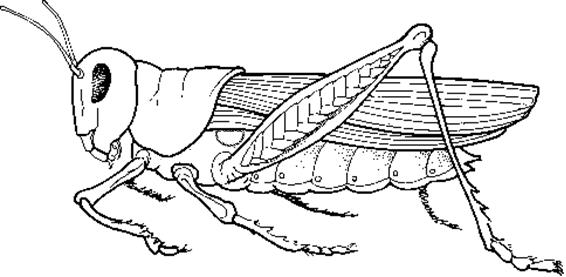GRASSHOPPER ANATOMY & DISSECTION
Introduction: In this lab, you will observe the external anatomy of a preserved grasshopper, locate structures and label a diagram. Internal anatomy is optional and can be observed after you have completed the external anatomy of the grasshopper.
PreLab Questions (use your book or other references)
1. Grasshoppers belong
to the Kingdom ___________________, the Phylum ___________________, the
Subphylum ____________________________, and the Class ________________________________
2. Use what you know
about classification to determine which of the following pairs is MOST
closely related.
[ Grasshopper & Crayfish ] or [ Grasshopper & Spider ] or [ Grasshopper
& Housefly ]
3. What kind of skeleton does a grasshopper have?______________________________
Anatomy of the Grasshopper - use specimens or pictures to examine a grasshopper, check the boxes as you complete each step.
5. Locate the segments on the abdomen. How many segments does your grasshopper have? ___________ Compare this number to other grasshoppers in the class. Do they all have the same number of segments? ________
6. Note the thorax. It is the center area to which all appendages attach. The hard covering of the thorax is called the carapace.
7. Locate the antenna. Is the antennae branched or unbranched? _____ How many antennae are there? ____
8. Locate the compound eyes. How many eyes does the grasshopper have? ______

9. Locate the grasshopper's legs.
To what part of the body are they attached? ____________ (head, thorax,
or abdomen).
How many pairs of legs does the grasshopper have? ____________
How many jumping legs are there ? __________ How many walking legs? _______
10. Notice the claws at the end of the legs. Do both sets of legs have these claws? ___
11. Locate the wings of the grasshopper. There are actually two sets of wings- one on the top and one underneath. The top wing is called the forewing and the bottom wing is called the hindwing. Which wing seems the most fragile?
12. Turn the grasshopper over and view the mouthparts.
Find the outside most plate (like an upper lip) which is called the labrum, its opposite is the lower plate (lower lip) called the labium.
The moveable mouthparts that look like antennae are the maxilla. Locate them.
The mandible is located under the maxilla and is used for chewing.
Does the mandible open from top to bottom or from side to side?Label the labrum, maxilla, and mandibles on the picture. Also label the compound eyes and antennae.
13. Raise the wings to find the disk shaped tympanum underneath. The tympanum functions as an eardrum. How many tympanum are found on the grasshopper?
14. Look at the abdomen and fine the row of holes along it; these are the spiracles and they function in respiration (breathing). How many spiracles do you count?
15. The sex of the grasshopper can be determined by looking at the lest segment of the abdomen. Females have a large pair of pointy structures called the ovipositor, which are used to deposit eggs into soil. Is you grasshopper a male or a female?
GRASSHOPPER COLORING
|
*Choose
a color for each structure, color the box and the structure
|
|||

Related Documents
Crayfish External Anatomy – focusing on the appendages and mouthparts
Internal Anatomy of a Crayfish – the body cavity is exposed to reveal structures such as gills and the green gland
Crayfish Virtual Dissection – images and walk-through of crayfish dissection


